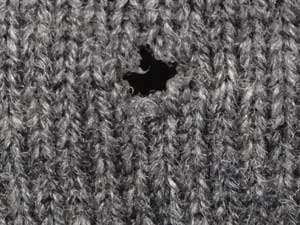Quiz questions and answers on past times
These quizzes are about how ordinary people lived in the UK in the early-mid 20th century. They are designed for individual use although they can be used in a group. They are just for your amusement. There is no signing in and nothing about you or your answers are kept. They are free, but are copyright.
Quiz 1. WHAT IS THIS?
Tap/click your chosen answer followed by the submit button.
Question 1
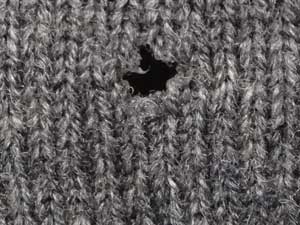
A common sight before the 1950s. What was it?
What made this hole in a woollen garment?
SORRY, WRONG
GOOD! You're right
The hole was made by the clothes moth, a moth which fed on wool – at a time when most garments were made of wool. With the development of man-made fabrics and plastic bags for wrapping woollen items, the clothes moth has largely disappeared – although it has not gone entirely. There is a page how people dealt with the clothes moth in the past. It will open as a new page. Just close it to return to the quiz.
Question 2
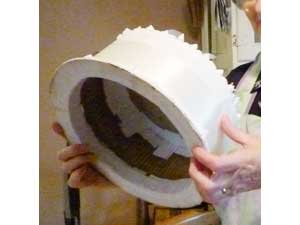
Common in the austerity years in and after World War Two. What was it?
What was this object used for in the 1940s and early 1950s?
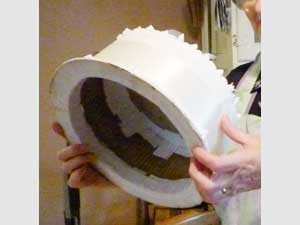
Fancy cake cover for a small, simple cake to make it look special
SORRY, WRONG
GOOD! You're right
This was a lavishly decorated wooden cake cover for a small simple cake which was all that was available during the rationing of World War Two and the years of austerity afterwards. The cake cover mimicked a large, fully iced wedding cake, and it was passed round from wedding to wedding. There is a page showing more photos. It will open as a new page. Just close it to return to the quiz.
Question 3
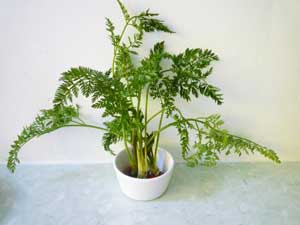
World War Two houseplant. What was it?
What was this houseplant in World War Two, bearing in mind the shortages of luxury items in the shops?
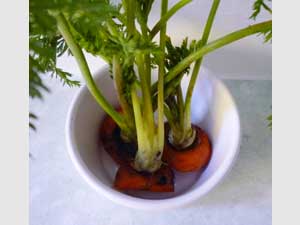
How carrot tops were grown as houseplants.
SORRY, WRONG
GOOD! You're right
After carrots were prepared for food, the tops could be put into a dish as shown in the photo and grown on. The result was attractive feathery foliage. There is a page on more details. It will open as a new page. Just close it to return to the quiz.
Question 4
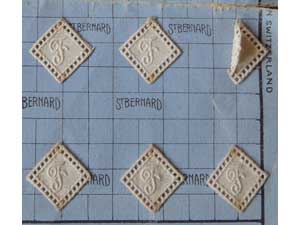
Linen shirt buttons. What was their main purpose?
Although there were all sorts of elegant buttons available in Victorian and Edwardian times, good quality men's shirts had linen buttons. What was the main reason?
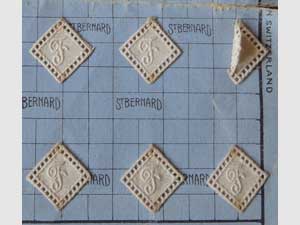
Embroidered linen shirt buttons
SORRY, WRONG
GOOD! You're right
Because there were no spin dryers, the majority of the water after washing had to be removed by putting the shirts through a clothes mangle. Its heavy rollers tended to break normal buttons, but the linen ones could not break and went through without damage. There is a page about clothes mangles. It will open as a new page. Just close it to return to the quiz.
Question 5

How was this glass poison bottle different from other glass bottles?
In the past, how were bottles of poisonous liquids distinguishable from bottles of other liquids?
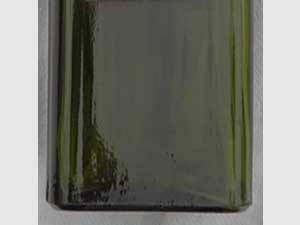
Enlarged portion of poison bottle showing the vertical ridges along its sides
SORRY, WRONG
GOOD! You're right
In the early years of the 20th century liquid poisons had to be sold in bottles made of dark glass with ridges from top to bottom so that people could see and feel that they contained poison. The colour of the glass did not have to be green; many were dark brown. There is a page about how goods were packaged. It will open as a new page. Just close it to return to the quiz.
Question 6
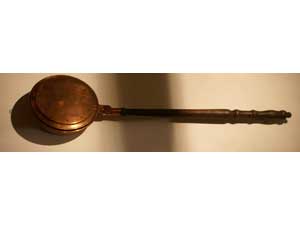
What was this object?
What was this object?
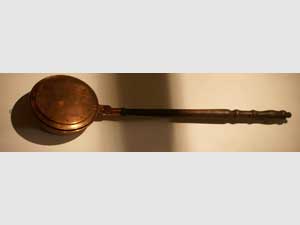
Warming pan/bedwarmer
SORRY, WRONG
GOOD! You're right
The picture is of a device known as a warming pan or bedwarmer and was, as its name implies, used for warming cold beds in winter. Before the middle of the 20th century there was no central heating, and beds in unheated bedrooms were cold in winter. To warm the beds, the lid of the pan was opened and a few hot coals from the fire put inside - there was always a coal fire somewhere in the house. The pan was closed and taken into bedrooms. The long handle kept it cool to the touch although the pan itself was hot. The hot pan was then slid between the bedsheets and moved round over them, so warming them.
Question 7
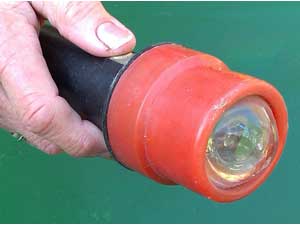
What sort of torch or lamp was this?
What was this object from the 1950s?
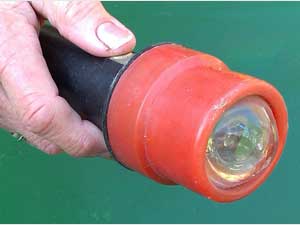
Usherette torch, 1950s
SORRY, WRONG
GOOD! You're right
The photo is of the special type of torch that cinema usherettes used when showing customers to their seats while the cinema was in darknes during a film. It was unsual in that the beam was more far reaching and narrow than that of a normal torch. There is a page about cinema usherettes in the heyday of British cinemas with a menu to more pages about old cinemas. It will open as a new page. Just close it to return to the quiz.
Question 8
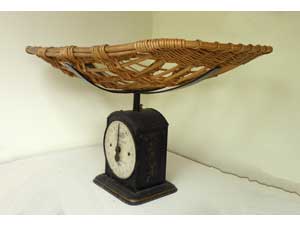
Scales designed for weighing what?
What was this designed for weighing?
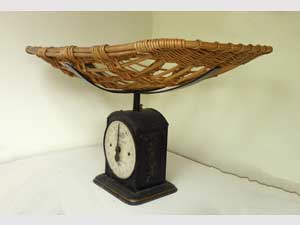
Scales for weighing babies
SORRY, WRONG
GOOD! You're right
The scales were for weighing babies during the middle years of the 20th century. Babycare was considered very important and there were clinics in most towns and villages where babies had to be weighed regularly. Their rate of putting on weight was taken as the first indication of their general health.
Question 9
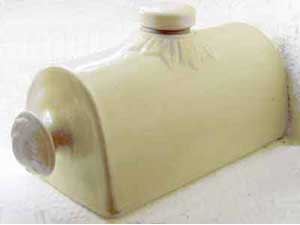
This was common in the early 20th century. What was it?
What was this container for?
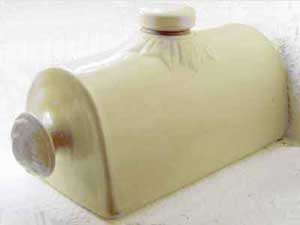
Stoneware hot water bottle
SORRY, WRONG
GOOD! You're right
Like the warming pan of the earlier question, this was used for warming cold beds. It was made of a type of glazed pottery known as stoneware and was filled early in the evening with boiling water from a kettle. Stoppers never fitted reliably, so the flat bottom prevented rolling over and so kept the the stopper on top, so preventing spilling.
Question 10
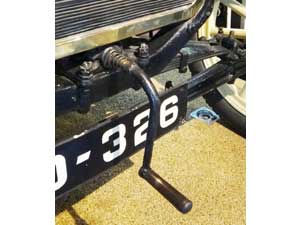
Essential part of an early car
This was an essential part of an early car. What was it?
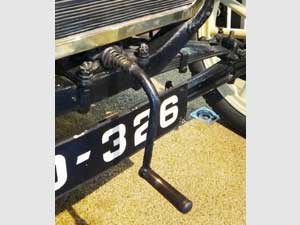
Starter handle of an early car
SORRY, WRONG
GOOD! You're right
This is the starter handle of an early car. To start the car, someone had to stand in front of it and give the starter handle one or more heavy handed turns to get the engine going. There is a page about travelling in old cars with a menu to other pages on aspects of old car travel. It will open as a new page. Just close it to return to the quiz.
Your quiz result
To retake the quiz, refresh the page.
sources: early 20th century material
sources: ww2 home front and other material
contact
the webmaster/author/researcher/editor
privacy policy
